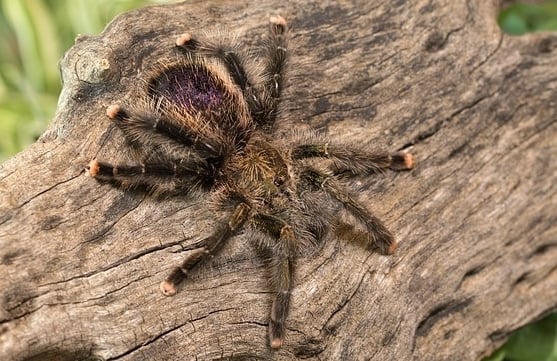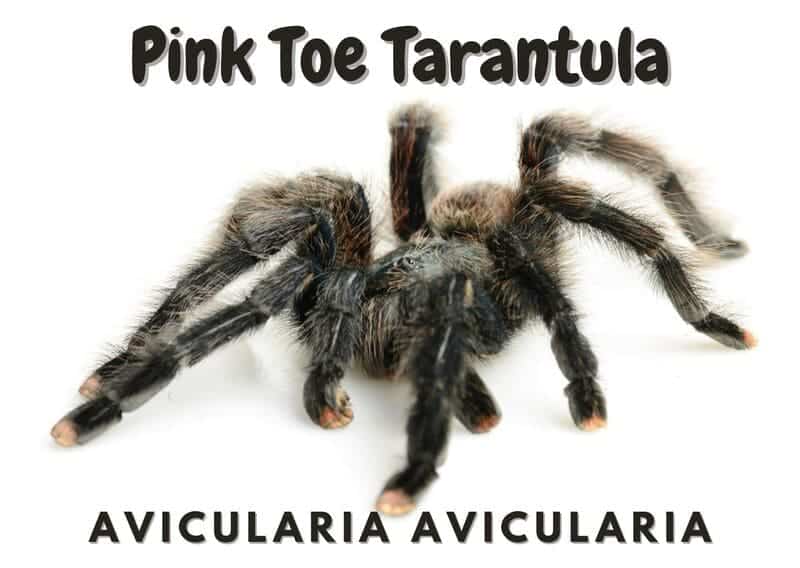The Pink Toe tarantula is absolutely a sight to be seen. It’s originally native to South America and it likes to live in trees and shrubs. Known to the experts as Avicularia avicularia, your Pinky spider can be an ideal pet that’s pleasing to look at.
If you are looking to own this curious-looking spider, here are some excellent tips on how to house them.
Pink Toe Tarantula Overview
| Scientific Name | Avicularia avicularia |
| Dwelling | Arboreal |
| Size | 6 inches |
| Lifespan | 3-4 years (male) / 12 years (female) |
| Food | crickets, cockroaches, grasshoppers, wax moths, small lizards, pinky mice |
| Difficulty | Beginner |
Scientific Name
Avicularia avicularia (Scientific name is Avicularia Versicolor). First discovered and identified by Linnaeus in 1758.
Characteristics of the Pink Toe Tarantula
It is one of the first tarantula species to be identified in the New World as the Pink-toed tree spider. It’s an arboreal species that shares 20 other species types in its family.

They are commonly found throughout Brazil and the Amazon basin, French Guiana, Martinique Guiana, Trinidad, Suriname, and Venezuela. These spiders are medium-sized and hairy, with a dark metallic black or gray color.
Often their body and leg hairs have additional purple/violet or reddish sheen combined with yellow highlights. Some identifying elements of the Avicularia avicularia are bright pink-orange tips on the end of each leg.
Size
Size is a factor that helps to determine the sex of each of the pink toe species. An adult female is 5 inches (13cm) in length whereas the males are 3.5 inches (9cm) in length. Males are typically smaller and have longer and thinner legs.
While both are considered very hairy or even fuzzy-looking, the female is much chunkier. Often a female is preferred because of their larger fluffier appearance. It should be noted that males will have darker abdomens than females.
Lifespan
Male pink toes live a shorter life than females with an average lifespan of 2-3 years. It’s not uncommon that most males who reach maturity will die soon after mating. Females live up to a maximum of 10-12 years and can reach maturity after 2-3 years.
Difficulty of care
Considered a perfect beginner spider, the Pink Toe tarantula is also a favorite for expert collectors too. Adults tend to be more slow-moving but keep in mind these are tree spiders by nature.
They are the most docile of all arboreal spiders but have built-in defense mechanisms. They are fond of jumping from one hand to another. Often it is common they will jump from your hand to your shoulder. They might even jump to the floor, which is why you need to be lower to handle them. One more strange fact is that they like to spray fecal matter as a quick defense if they are scared.
Housing the Pink Toe Tarantula
You will need an enclosure that is taller than a standard tank setup. It should be taller since you will need to put a live plant inside. Since the pink toe is arboreal it needs to live in trees rather than on the ground. Keep in mind that your enclosure should be 4x the size in height of your spider’s overall size. A typical enclosure can be 12″x 12″ x 18″ and should have an access hatch on the side and top.
We recommend glass since this is easier to see through than some plastics. It’s not uncommon that some owners will choose plastic Tupperware containers, and then modify them.
Cleaning
The job of cleaning their living area depends on how often they feed. Dead dried-up insects and small animals should be clean-up as soon as possible to keep bacteria from growing. Since a live plant is inside your habitat, the humidity will naturally be higher. Pay attention to the kind of substrate that is used to keep mold or bacterial growth to a minimum.
The Pink Toe tarantula will often make their webbing around the top of the enclosure. If you decide so some cleaning, be sure to remove all the old webbing from the plant and inside surfaces.
Accessories
The best advice is that less is more with our pink toes. They spend most of their day in the trees and bushes so an uncluttered floor is advised. This helps make it easier for cleaning too. It also keeps the bacteria problems better to handle. Be sure to find a sub-tropical plant that is good for climbing.
Humidity
Your pink toe will love high humidity since they are a sub-tropical spider. You will need to have a hygrometer and thermometer. Keep the inner enclosure at least 75-80% for humidity all year long. When it comes to the temperature you can rest a bit easier. They are extremely hardy when it comes to temperature variations in nature with 60-80F.
Temperature
Make sure the inner temperature is ranging between 78-82F for a comfortable habitat. If your live plant is not giving enough humidity, you can use a spray bottle to mist the inside of the habitat. Keep an eye on the hygrometer to ensure its humidity is not over the limit.
Lighting
Be safe be sure to add some kind of lighting to keep them warm. Do not use any heat lamps – a standard desk lamp with a 40-watt incandescent bulb is sufficient. It should be placed outside the enclosure and above the spider. Simulate their natural day with no more than 12 hours of light per day.
If you decide to use a heating pad, choose one that is low heat and place it under the enclosure. They have sensitive feet and hot surfaces can hurt them. Your enclosure will do the rest to keep in the heat they need so make sure that a lid doesn’t have too many holes or a screen at the top. This will vent the heat outward and lose the conditions they need.
Substrate
You don’t need much for keeping a Pink Toe tarantula happy, it’s not going to be digging burrows so the substrate doesn’t need to be moist. However, you do need a surface that is walkable if they do come down from their plant hangout.
There are many kinds of substrates you can choose from to line the floor. It can be a combination of cork, bark, and sphagnum moss. On the very bottom, it’s important to use some kind of moisture-retaining material.
Use a combination of peat moss and vermiculite with no more than 25% topsoil. Remember that you don’t need to have so much moisture in the substrate as this can induce bacterial growth. You can even opt to use some coconut fibers to prevent further growth.
The floor material should ideally hold your plants and bark that leads up to the top of the enclosure. Be sure to put in a hiding tube that is hot glued to some bark or cork. It should be large enough that your pink toe can get inside easily.
Feeding Habits of the Avicularia Avicularia
Thankfully the pinky toe doesn’t need exotic bugs to keep them happy. You can give them a steady diet of live crickets. This is not to say that they won’t enjoy cockroaches, grasshoppers, and flying insects. They will especially enjoy wax moths. These should be given in rotation or when these selected treats are available.
The Pink Toe tarantula is also known to eat select species of lizards too. They usually prefer the Anolis species which is native to their South American diet. These should be small enough for your Pinky to handle otherwise the lizard might try to harm your spider. Juvenile Anoles would be best. Another favorite if you prefer can be pinky mice that will fill out their dietary needs.
How often should the Pink Toe tarantula eat?
Adult pink toes will eat about 2-3 live crickets per week. They must be alive since this species of spider likes to hunt. This will happen at night, so place your crickets in the habitat when you go to bed.
There is no feeding schedule for juveniles since they essentially don’t grow overweight. When they are done feeding, they stop that’s it! You’ll need to give juvenile tarantulas smaller crickets that are called nymphs. These are about one-quarter the size of a normal size cricket.
Whatever is left over in the morning is what you should take out. Dried bug shells should be removed too. If you have juvenile spiders they can be fed as much as they can eat. Since juvenile molt, every two weeks for the first months, wait a couple of days until they harden up enough.
Drink
A water dish is advised since the pink toe breed does like to drink from time to time. Make sure that the water dish is not deeper than they can step over it easily enough. No bigger than a soda cap and no larger than a Snapple cap.
Change the water every other day and especially if it gets substrate in it. They like clean water too. Place water at the same level as the substrate, when your pink toe approaches, it can get to it easier.
Handling the Pink Toe Tarantula
Even though the pink toe is pretty docile it can be easily skittish at times. Even jumping and running off in one direction to avoid danger. If you raise them when they are juveniles, they will be easier to manage as mature spiders. They aren’t aggressive by nature and seldom bite. Most of the time, they are usually slow-moving spiders.
They do tend to jump since this is their nature, which is why you need to raise them when they are young. They will learn your handling habits and be calmer as they grow.
Mature adults might have bad habits that include fecal spaying which can be problematic. As far as biting goes, their bite is not deadly for humans. If you suffer from bee stings, you could have a severe allergic reaction.
Common health problems affecting the Pink Toe Tarantula
There are some random dangers for your Pinky spider concerning mites. Mites can become a troublesome parasites for spiders and often breed in the substrate material. If these mites invade the mouth area of your spider, it can make them sick and even kill them. It’s recommended that you clean out the substrate material at least once a month.
Another health problem can be dehydration so always make sure your spider has its water dish ready and waiting. Too much humidity is also not good for your spider.
Monitor the enclosure and be sure that humidity is at a level the pink toe is comfortable with. For an owner who has never seen molting, this can be worrisome as well. Your spider will become sluggish and lazier than usual. When they are ready to molt they will flip over and look like they are dying. What they are doing is getting ready to exit their exoskeleton.
Don’t bother them during this time they need time to remove each leg and appendage from their old housing. After they molt you should not try to feel them either. They need time to dry so older spiders can take weeks depending on their size. Juveniles will only need a couple of days.
Breeding the Pink Toe Tarantula
A mature male will be ready to mate after two or three years. When they are ready to mate they produce their sperm which is woven into a special web that they carry to the female. On the ends of their two front legs are specially adapted hooks. These hooks aid with moving the female’s fangs to deposit his sperm sack easier.
A male will be ready to reproduce after they have molted the second or third year in a row. They should be allowed 6 weeks to properly dry up their exoskeleton.
After mating, the male will usually live for another 3 months and then die. The female will be ready to reproduce in 2-3 years. In that 2nd or 3rd year after she molts, she will be ready to mate. After that, she will not mate again until her next annual molting.
How many eggs?
After mating, the female Pinky can produce anywhere between 50 to 200 eggs. She then covers the eggs in a silk sack that she will protect. Be sure to feed her as often as she will need at this point. After 6-8 weeks, these eggs will start to hatch.
What to do with the spiderlings
These eggs must be removed from the enclosure and stored in a warm area similar to your enclosure. Around the 5th week mark, be sure to separate each egg so they are easier to manage. Little plastic take-out containers with holes poked in the lids work best.
You can raise these spiderlings or sell them to authorized buyers who can resell them for you. Spiderlings are a full-time job and you’ll spend all day feeding hundreds of baby spiders. Perhaps it might be too much work for you, so sell them off while you can.
Availability of the Pink Toe Tarantula
The Pink Toe tarantula is not an endangered species but is very popular as a pet. You should always look at the species you are buying since there are 20 variants in this spider. Not all of them look the same and have the same colors. Some have black toe tips with light pink legs. Others can have a rusty overall color with little pink toe tips.
Some still might be more bristly than you want, looking like a toilet brush. It comes down to a selected color type. Be sure to ask your seller what kinds are available. Bring a picture of the exact type you want and they will be able to identify the correct family species for you.
Always be sure to make sure they are not overcharging you as well. Compare prices before you start to buy.
References and further reading
- Avicularia avicularia (Pink-toed Tarantula), The Online Guide to the Animals of Trinidad and Tobago
Contents
- Pink Toe Tarantula Overview
- Scientific Name
- Characteristics of the Pink Toe Tarantula
- Housing the Pink Toe Tarantula
- Feeding Habits of the Avicularia Avicularia
- Handling the Pink Toe Tarantula
- Common health problems affecting the Pink Toe Tarantula
- Breeding the Pink Toe Tarantula
- Availability of the Pink Toe Tarantula













